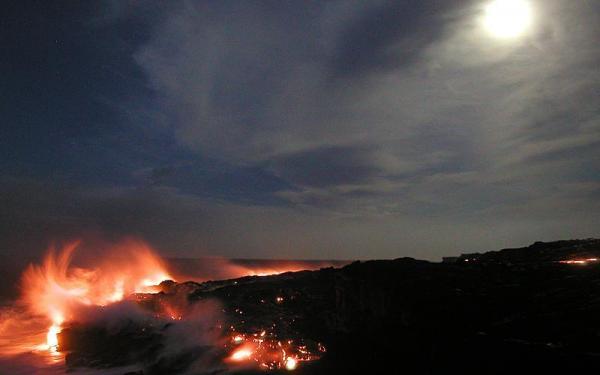Volcano Watch — Kīlauea lava meets the sea again: will you be assaulted by a salty (and stinging) plume?
"The only constant is change" is an adage that certainly applies to Kīlauea Volcano. Over the past weeks volcano watchers have been treated to views of incandescent lava patches high above the coastal flats, spectacular streams of lava cascading down cliffs, lava-induced forest fires, and surface lava toes, lobes and rivulets edging toward the sea.
Lava flow-field visitors who continued to burn the midnight oil until 2:00 a.m. on Friday, July 19, were treated to the first views of lava entering the sea since January, when both the nine-month-old ocean entry on the Kalapana (east) side of the flow field and the five-month-old flow at Kamoamoa shut down. Visitors approach the current ocean entries via the Chain of Craters Road in Hawai`i Volcanoes National Park, in an area that last enjoyed an ocean entry in 1995.
Since more than 80 percent of the world's volcanoes are submarine and erupt completely underwater, or are situated on islands or coastlines, the interaction of lava and seawater is a common occurrence. Currently however, Kīlauea is the only volcano above sea level pouring molten rock into the ocean.
When lava meets the sea, large steam plumes (dubbed "laze" for lava haze) are created as the more than 1100?C (2012 ?F) lava boils and vaporizes seawater. A portion of this steam recondenses and rains out of the plume as acidic precipitation that has been enriched with seawater salt, and contains tiny glass fragments generated by the intense physical interaction of hot lava and cool seawater. The pH of the plume precipitation is between 1 and 2, or between that of battery acid and pure lemon juice. This acidity arises from two main sources. When molten rock and seawater react, the heat from the lava causes the salt in the ocean to break apart and react with water to form hydrochloric acid (the same acid that is in our stomachs). The main salt species involved is likely sodium chloride (table salt), although magnesium chloride may contribute as well. At least 70 percent of the acidity is generated by molten rock-seawater interaction.
The other source of acidity is from the magmatic gases in the lava itself. Unlike an open beer or soda that loses its carbonation on a long journey, molten rock traveling the more than 30 km (18 miles) from beneath the summit of Kīlauea to the sea, retains some of the gases that originally carried it up to the surface of the earth. These gases, in particular sulfur and fluorine gases, react with water creating sulfuric and other acids. When Kīlauea is erupting at a typical rate, and just one third of the erupted lava is flowing into the sea, the amount of acid generated at the ocean entry is comparable to the largest industrial sources of sulfuric and hydrochloric acid in the nation-or the equivalent of the acid from about 30,000 car batteries, each day.
Under normal trade wind conditions, the ocean entry plumes are blown over the adjacent coastal areas, creating whitish deposits on the flow field near the ocean entry. Some of the deposits are due to the alteration of basalt by the acid plume precipitation, while others are formed after the salty precipitation evaporates leaving the salts behind.
Observers in the path of the ocean entry plume may encounter a mist or rain of what amounts to a mixture of salty battery and stomach acid, laced with tiny glass shards. Even if moisture is not felt downwind of the ocean entry, a non-condensing plume still contains hydrochloric and other acid gases. Inhaling or contacting acid gases and liquids can irritate the skin, eyes and respiratory tract and may cause breathing difficulties, particularly to those with pre-existing respiratory problems. Sufficient exposure to hydrochloric acid can also cause nausea, vomiting and dehydration.
Since early June, when spectacular lava viewing returned to the National Park, on some days, more than 3,000 people have visited the flows. The intrigue, appreciation and curiosity of visitors is delightful- but should be tempered with sensible caution. As the park recommends, "approach the flows, avoid the fumes".
Volcano Activity Update
Eruptive activity of Kīlauea Volcano continued unabated at the Pu`u `O`o vent during the past week. As mentioned above, a lobe of the "Mother's Day" flow entered the ocean west of the old "High Castle" entry at 2:00 a.m. on July 19. Two days later, a second lobe crossed the end of the Chain of Craters Road and entered the ocean near Wilipe`a, 600 meters (650 yds) southwest of the first entry. Both the West Highcastle and Wilipe`a ocean entries are forming benches and adding to the size of the island. The lava viewing is spectacular, and the National Park Service is allowing visitors to hike out and get up close to the active flows.
The eastern Boundary flow emanating from the "rootless" shields still lives. Two stubby flows and several incandescent spots were observed on Pulama pali.
One earthquake was reported felt during the week ending on July 25. Residents from Papa`ikou to Volcano and throughout Puna felt an earthquake at 5:31 p.m. on July 21. The magnitude-3.7 earthquake was located 12 km (7.2 mi) south of Volcano at a depth of 8.2 km (4.9 mi).
Get Our News
These items are in the RSS feed format (Really Simple Syndication) based on categories such as topics, locations, and more. You can install and RSS reader browser extension, software, or use a third-party service to receive immediate news updates depending on the feed that you have added. If you click the feed links below, they may look strange because they are simply XML code. An RSS reader can easily read this code and push out a notification to you when something new is posted to our site.





